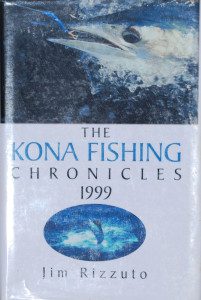We are reprinting this story from The Kona Fishing Chronicles of 1999. We first published it in our weekly column in June 1999. It tells the tale of a very mystifying case of mistaken identity for what was thought to be the largest bluefin trevally (omilu) ever caught.
Dateline June, 1999. The 1999 yearbook of the International Game Fish Association has begun arriving in island mailboxes. The big news it carries for ulua fishermen may be something that is not included.
 Bear with me through a tangled tale of an event now a dozen years old.
Bear with me through a tangled tale of an event now a dozen years old.
It was around Christmas on Christmas Island in 1977, and Santa was about to give Dr. Herbert Montoya an unusual gift with many long strings attached.
In the dark of the night, the Honolulu shorefisherman hooked and landed a 96-pound jack. The husky fish was a great trophy, though not unusually big for the species Caranx ignoblis – the giant trevally.
Montoya posed with his catch for a flash picture taken against the inky blackness of the equatorial night and thought nothing more about the identity of the fish until the picture was developed.
When he saw the print, however, he began to wonder whether he had really caught a GT or something much more spectacular.
The image on the print was not in the classic gray, silver and charcoal tones of the GT. Instead, the fish had a decided bluish cast.
Could this be an enormous bluefin trevally instead?
At that time, the all-tackle world record for bluefin, Caranx melampygus, was well under 30 pounds. Still, rumors have persisted that the species grows to gargantuan proportions.
Montoya submitted his catch, with the picture, for consideration as a bluefin and left it up to IGFA scientists to determine.
To the great surprise of many local ulua fishermen, the IGFA concluded that it was a bluefin and gave Montoya the all-tackle record despite the improbability – it was nearly five times as big as the largest bluefin previously recorded.
Skeptics here and throughout the Pacific were dumbfounded.
In this column, we highlighted the issue by making some comparisons.
For example, the largest aku on record weighs over 40 pounds. Suppose a fisherman brought in a 200-pound tuna and submitted it as an all-tackle record for aku? You would think he was nuts.
Consider, instead, the Pacific shortbill spearfish record, which stands at 72 pounds. Imagine that someone submitted a 350-pound marlin as a spearfish and successfully claimed the title!
At the time the decision was announced, in my role as an IGFA representative, I asked the IGFA to reconsider. But the trevally scientists who advised the IGFA were adamant, citing other physical features besides the color.
Their analysis may have satisfied some, but it allayed no doubts among local fishermen who know a giant trevally when they see one.
The photo shows a fish that in all physical ways resembles a GT, not a bluefin. The head is high and blunt, not long and conical, for example. The scientists shrugged and said that body proportions change with size and maturity.
Perhaps it was a hybrid?
There is no evidence of hybridization among jack species, came the reply. The scientists were entrenched.
In a 1988 letter to me, then IGFA president Elwood Harry wrote:
“We have made a careful review of this fish among various leading scientists including William F. Smith-Vaniz, Associate Curator of Icthyology at the Academy of Natural Sciences, and Dr, Richard Robbins, who heads the international committee for the establishment of common and scientific names for fishes.
“The results of our review are that there is a general agreement that it is not a C. Ignoblis and that it must be classified as a Caranx melampygus.
“It has been discussed that the fish might still possibly be a hybrid, but in the absence of any independent confirmation of hybridization between these two species, any thought of classifying it as a hybrid would have to be dismissed.”
The IGFA was stuck defending what appeared to be an absurdity to everyone but its scientific advisors.
There was a chance, however, that its feet could be pulled out of the fire if someone else caught another gigantic bluefin. There were, after all, those rumors of other gargantuan members of the clan.
But more than ten years passed without a confirming catch. No bluefin of similar size has been caught at Christmas Island – or off Mexico, the Maldives, Palau, Australia, Costa Rica, Japan, South Africa, Mozambique, Hawaii, or anywhere else in the Indo-Pacific that is home to this wide-ranging species.
Last year, we wrote about the controversy in a West Hawaii Today column dated March, 1998, and asked the IGFA to take another look from the long lens of history.
We heard nothing more about the matter until the new book arrived a few weeks ago without the questionable record.